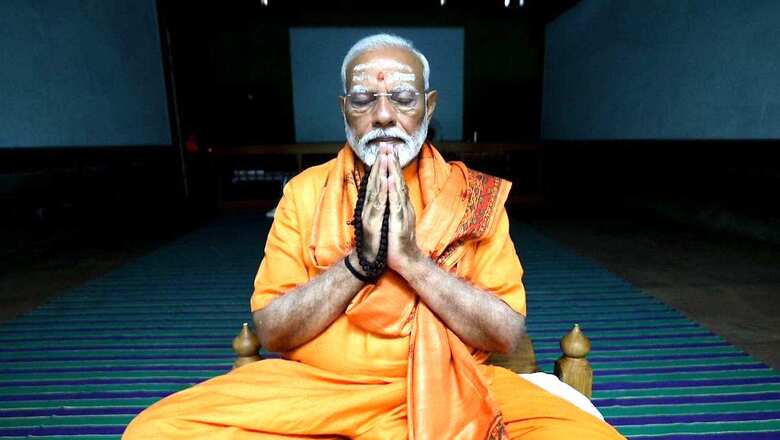
views
Worldwide there are Presidents and Prime Ministers who regularly take holidays. India has also had PMs taking a break, and sometimes landing in hot water for it too. The Indian-origin British PM is being criticised in election season there for his California holiday last year with insinuations that he will “run away” thereafter his party’s expected defeat next month. The idea of a PM taking a meditation break after a particularly gruelling campaign season is almost unheard of.
In May 2023 researchers from Oxford University and institutions in Singapore, Sweden and Australia published the findings of their study ‘Mindfulness in Politics: A Qualitative Study on Mindfulness Training in the UK Parliament’. Their study of some of the British MPs who had attended mindfulness sessions concluded it is beneficial at personal and professional levels, and even suggested that the government should introduce permanent training schemes.
This is because the UK study revealed that mindfulness training helped politicians deal with the stresses of their profession, enabled them to connect with themselves, become more centred and grounded, and deal with others and different viewpoints more humanely. Over the past decade, over 300 British MPs from upper and lower houses have undergone mindfulness training in the Buddhist tradition and there is even support for a meditation room in Parliament.
It is not known which parties they belonged to but given the dissension within the ruling Conservatives and the opposition Labour party, none of them have been meditating or mindful of late. But neither have many in the Indian political and chattering classes, it seems. Derisive comments and memes about Prime Minister Narendra Modi choosing to spend part of the last few days of his second term meditating in the south shows Indians also need introspection sessions.
Peripheral issues about his 45-hour meditation break at the Vivekananda Rock Memorial—his attire, the cameras—dominated the discourse within certain circles, most of whom are either unmindful of the known benefits of meditation or simply habituated to scorning traditional Indian concepts. They are, however, all for holiday breaks—which Western leaders are known to practice assiduously come hell or high water—and deride those in India who do not take them!
The two words mindfulness and meditation are mostly now used interchangeably and often in a secular context but there are differences. The former is rooted in the Buddhist tradition and focuses on rising above thoughts and emotions so as to objectively understand the true nature of reality. In Hinduism, meditation is a tool to calm internal disturbances so that people can tap into their innately divine nature. But it’s been a long time since the Beatles made meditation trendy.
The acceptability of ‘mindfulness’ over ‘meditation’ in the West may explain the derogatory reactions to Modi’s contemplative sojourns at Hindu pilgrimage spots over Rahul Gandhi’s frequent getaways to ‘retreats’ abroad to practice Vipassana, a mindfulness practice that has deliberately been distanced from its Buddhist past, presumably to avoid putting off those allergic to anything religious. Meditation, often with silent recitation of a mantra, doesn’t obviously make the cut.
Hindu scriptures say that silent meditation helps people to rise above dualities and distractions caused by negative and positive thoughts. Both meditation and mindfulness also use yogic breathing techniques to transcend the body to connect with the inner divinity. The difference is that mindfulness and some aspects of yoga have been delinked from their roots in religions for wider acceptance. Modi by making revered spots the venue for meditation reasserts that linkage.
A major gripe about the PM’s meditation break is his unique interpretation of the term ‘silence period’ that is supposed to precede every phase of voting in Indian elections and its location. He chose to be silent in Kanniyakumari in 2024 and in 2019 he meditated—silently—in a cave through the night at the holy shrine at Kedarnath. As the challenger in May 2014, Modi went to Pratapgad Fort, where Chhatrapati Shivaji got his very first military victory against Afzal Khan.
Apart from the significance of Modi’s choice of venue for his meditation sojourns—first in the west, then the north, and now the south of India—the fact of choosing this as the way to unwind and gear up for the future is markedly different from his peer group. Modi is not one to take holidays on the job, and his ministers and bureaucrats are also urged to keep up a scorching pace right through the year. These meditation breaks are the only time he is still and at rest.
Holidays are the acceptable form of unwinding among the cohort of Presidents and PMs, not meditation breaks. Indian leaders have also incorporated them into their schedules. Jawaharlal Nehru started it nine months after independence, by vacationing with the Mountbattens in Shimla in 1948, and even took his daughter and grandsons on a trip to Indonesia aboard the Indian Navy’s INS Delhi in 1950. He took them along on several extended official tours abroad as well.
Indira Gandhi and Rajiv Gandhi also took family holidays, with the latter actually getting flak for sailing on India’s aircraft carrier INS Viraat to an inland vacay along with family and assorted friends in Lakshadweep in 1987. As PM, Atal Behari Vajpayee would go to Himachal Pradesh for annual summer breaks lasting up to 10 days and even did so after demitting office. Vajpayee also took time off to stay for a week in Kerala, as did Nehru and Rajiv Gandhi in their day.
Maybe this tradition is a hangover from the days that India was a British colony as prime ministerial holidays are a long tradition there, with the incumbent of 10 Downing Street even being provided a country home, Chequers, to unwind in. That happy tradition was most abused by Boris Johnson who went off on a Scottish ‘staycation’ as Covid-19 began spreading in 2020. He also fitted in holidays with his third wife and children in Greece and Slovenia in his final days as PM.
US presidents mostly relax in their homes or vacation spots within the country. Barack Obama was an exception, travelling with family to Cuba, France, Canada and Mexico. Joe Biden goes to his home in Delaware, Donald Trump retreated to his Mar-a-Lago estate, the Clintons went to Martha’s Vineyard and the Bushes to their Texas ranch. They all had access to the official getaway Camp David too. But do they and their European counterparts use ‘downtime’ for meditation?
The Sanskrit word for meditation, dhyana, also means contemplation and reflection, a flow of awareness and non-judgmental observation. The Indian-origin British PM, aptly named Rishi, should start a new tradition of meditation as July elections loom there. Indeed, the world will be a better place if more leaders take a cue from Modi and spend time meditating—or practising “mindfulness” if they want to sound trendy—during their terms in office. And after.
The author is a freelance writer. Views expressed in the above piece are personal and solely those of the author. They do not necessarily reflect News18’s views.


















Comments
0 comment